Cat Flap Installation Cost
Last updated 23rd March, 2025
Thinking of having a cat flap or dog flap installation but unsure of prices? Well, look no further.
The cost of cat flap installation can range between £80 and £510.
However, the prices you're quoted for installing a pet flap will depend on the type you want and whereabouts you want to put it.
This pet flap cost guide will discuss how much you'd likely pay to install various types of cat and dog flaps in the UK.
Let's get straight to it!
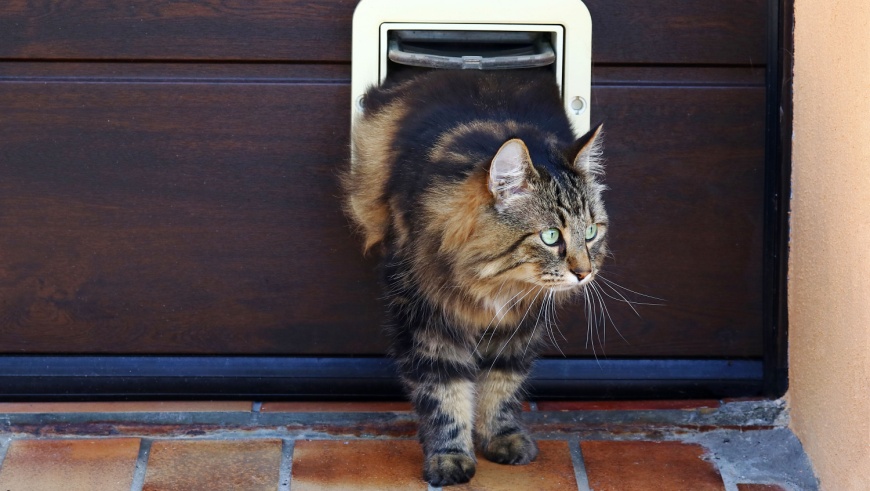
How Much to Install a Cat Flap?
Here, we'll give an overview of the average cost of pet flap installations. These will vary depending on the type of pet flap and door or wall type.
The installation cost will vary depending on the type/brand of the pet flap, ease of access to the work area, the state of the installation area, the type of door, and the property location.
As for the last point, where you are based is relevant given that labour prices vary across the UK.
Advice on how to calculate a more accurate estimate for your individual installation will be provided later in this guide.
Cat Flap Installation Prices
| Type of Door | Total Cost |
|---|---|
| Glass French Door | £150 - £340 |
| Wooden Door | £80 - £210 |
| Composite Door | £120 - £280 |
| uPVC Door Panel | £80 - £210 |
| External Wall | £240 - £540 |
Table of Contents
- How much to install a cat flap?
- How much does installing a cat flap cost?
- What impacts cat flap installation costs?
- What does installing a pet flap entail?
- DIY pet flap installation
- How much do different types of cat flap cost?
- Pet flap repairs and maintenance
- Pet flap removal cost
- FAQs
- How to find and hire a pet flap installer
- Sources
How Much Does a Dog or Cat Flap Cost?
How much do the pet flaps cost on their own? Say you want to buy the pet flap and install it DIY. In this case, you’d be concerned only with the supply cost of installing a pet flap.
| Type of Pet Flap | Supply Costs |
|---|---|
| Classic pet flap | £80 - £190 |
| Lockable pet flap | £70 - £210 |
| Magnetic pet flap | £50 - £260 |
| Infrared pet flap | £80 - £260 |
| Microchip pet flap | £80 - £260 |
Additional Cat Flap Installation Costs
What else might I pay for? In this section, we’ll break down some common additional jobs that homeowners may choose to have undertaken, along with the installation of a pet flap.
Door Lock Replacement Cost
You may wish to change a door lock for increased security or because your current lock has worn down beyond repair. There are various door lock replacements available and the cost of a lock change can usually meet most budgets.
Cost of New Front Door
The entrance door of a property is the first standout feature of a property people see when visiting a home. And, as with the cost of replacing a door lock, the cost of installing a new front door can vary greatly.
Home Security Costs
A cat or dog flap installation may make your home more vulnerable to burglars, so improving home security more generally might be worth considering.
Potential costs to factor in include the cost of an alarm system if you choose to fit one. Similarly, you may want to consider CCTV system prices as part of your measures to protect your home.
Cat Flap Cost Breakdown Calculator
Individual cost to supply & fit a classic pet flap to a wooden door – Total Cost: £110
Materials
£55
Labour
£55
Waste Removal
£0
How Much Does Installing a Cat Flap Cost?
Let’s now discuss the labour costs of each pet installation job. In this section, we’ll also look at factors that shape the labour price and timeframes.
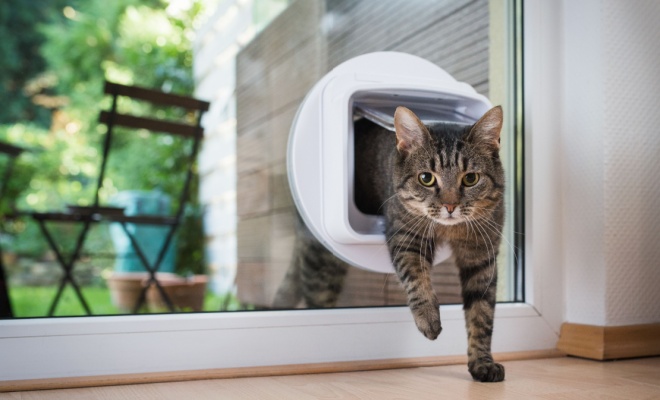
Here’s another thing...
On average, a tradesperson will charge around £40 to £50 per hour to install a pet flap. This, along with the supply costs, will add up to the total cost of a pet flap.
Breakdown of time frames:
- Installing a small pet flap - 1 to 2 hours
- Installing a medium pet flap - 1 to 3 hours
- Installing a large pet flap - 2 to 4 hours
Labour Cost and time frame factors:
- Size and type of pet flap
- Type of door/wall
- Ease of access
- State of the work area
What Impacts Cat Flap Installation Costs?
We’ll now take a closer look at the factors that shape the cost of paying a professional to fit a pet flap. Let’s explore various cost factors, such as the type of door and ease of access.
Size of Pet Flap
Of course, the larger the pet flap, the more it will cost to buy. In addition, a larger pet flap would probably cost more to install, given that the labour times are likely to be extended as a result.
Type of Door
It can sometimes prove easier to fit a cat flap or dog flap to some types of doors over others. However, the material itself is usually not very relevant, compared to the quality and style of the door.
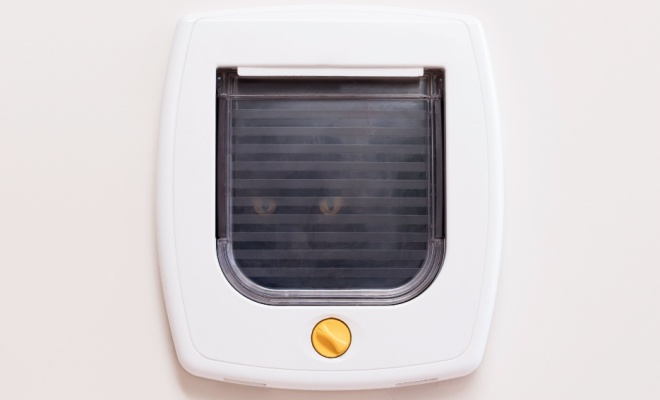
Size of Installation Area
The larger the area in which you wish to have a pet flap installed will generally correspond to a longer installation and, therefore, possibly a higher labour cost.
Location of Property
Labour prices will differ depending on where you live, however. For example, labourers are likely to charge less in the north of England, Scotland, and Northern Ireland but more in regions like the southeast of England.
Ease of Access
The more accessible the area of work is, the quicker the job is likely to be. In turn, the sooner a contractor fits a pet flap, the lower the labour cost will probably come to. The opposite is, of course, also true.
What Does Installing a Pet Flap Entail?
Now, let’s break down the steps involved in fitting a new pet flap. The exact method needed to install a pet flap will vary based on the type of pet flap and door.
A pet flap for glass door installation or a pet flap for wood door installation will be a different process.
1. Hiring a Contractor
You may wish to fit a pet flap DIY. However, if you’d prefer to hire a professional, you should acquire a minimum of three quotes from various tradespeople/companies, as well as references, before coming to a decision. This will give you better odds of hiring an above-average contractor and finding a better deal.
2. Cutting the Circle For a Pet Flap
The first step involves making the necessary measurements to know where the pet flap should be fitted exactly and where the hole will be cut out to fit the pet flap (plus its dimensions). At this stage, the labourer will outline the pet flap on the door.
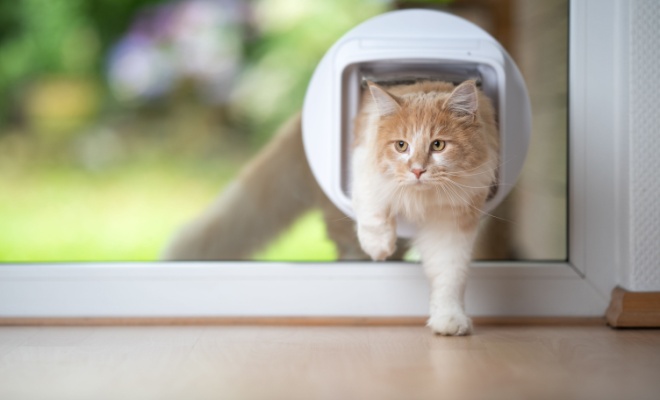
Next, they will drill holes on the circle’s outline before employing a jigsaw blade to cut out the circle needed for the installation. It’s important to ensure that your pet is not behind the door when the hole is being cut!
Different tools and equipment will be needed depending on the door material. For instance, an electric jigsaw blade would be used to cut out a circle in a uPVC door.
3. Installing the Pet Flap
Next, in the case of a wooden door, sandpaper may be used to tidy up the door hole. It’s important that the pet flap is checked to ensure that the flap swings as it should.
Then, it’s time to drill the fixing hole before fitting the pet flap, per the manufacturer’s instructions. Finally, the pet flap should be checked one more time to make certain that it’s working correctly.
DIY Pet Flap Installation
You may fit a pet flap DIY if you wish. It’s a relatively simple job, and the manufacturer will provide instructions that should be easy to follow.
Of course, with any DIY job, there are risks involved. For one, it’s always important to take caution when using tools like drills or jigsaw blades.
In addition, if you want to fit a pet flap to a wall, a cable detector is necessary to pick up on gas, waste, or waste pipes, and electric cable before cutting through. Also, it’s essential not to cut through a structural timber or RSJ.
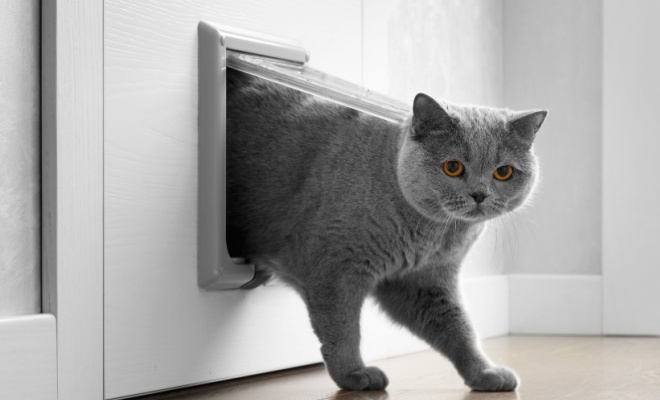
If you doubt what is behind a wall, you should hire a professional to fit a pet flap to said wall.
A less serious but notable risk is that you could perform the job incorrectly. For that reason, only fit a pet flap DIY if you feel sure that you’ll be able to undertake the installation right. You’d possibly save somewhere in the range of £80 to £260 if you fit a pet flap DIY.
The Tools/Equipment to Fit a Pet Flap to a Wooden Door:
- Measuring Tape
- Drill and Drill Bits
- Jigsaw Blade
- Screws
In the case of a uPVC door, you’ll need an electric jigsaw blade. A drill must be used to cut through a wall. Other materials will be needed for fitting pet flaps to different types of surfaces.
In any case, the manufacturer will provide you with details and hopefully some, if not all, of the materials needed (e.g., an adhesive). You will not need a professional sign off once the pet flap is installed.
How Much Do Different Types of Cat Flap Cost?
In this section, we’ll discuss the features of each design of pet flap, their costs, and pros & cons, among other details.
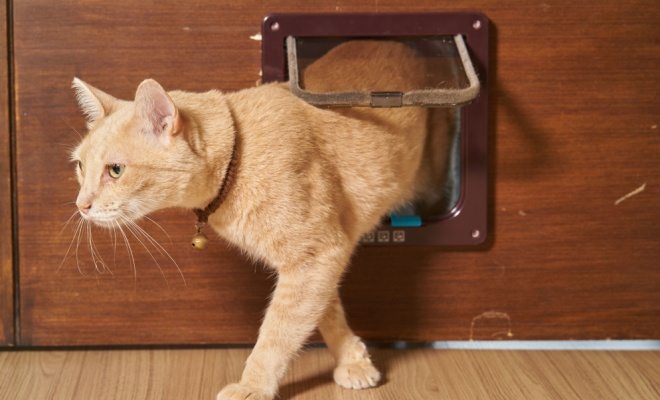
Classic Cat Flap Cost
| Door/Wall Type | Total Cost |
|---|---|
| Glass French Door | £160 - £260 |
| Wooden Door | £80 - £140 |
| Composite Door | £130 - £200 |
| uPVC Door Panel | £80 - £140 |
| External Wall | £250 - £440 |
Also known as a conventional pet flap, this choice is as simple as it gets; it is a pet flap door that opens and closes manually. Classic pet flaps are cheap and simple.
On the other hand, they do not provide much security since pets from throughout the neighbourhood, and possibly wild animals, could enter your home with ease. Classic pet flaps cost about £80 to £190 per unit from retailers depending on what type of door they're being fitted into.
While a classic style pet flap is a cheap cat flap, the costs can soon mount up depending on the type of door or wall you have. For instance, installing any type of pet flap on an external wall will increase costs, even if the cat flap itself is a cheap one.
Pros:
- ✔ Simple
- ✔ Not costly
Cons:
- ✖ Will not protect against bad weather
- ✖ Lack of security
Lockable Cat Flap Cost
| Door/Wall Type | Total Cost |
|---|---|
| Glass French Door | £150 - £270 |
| Wooden Door | £80 - £140 |
| Composite Door | £120 - £200 |
| uPVC Door Panel | £80 - £140 |
| External Wall | £240 - £450 |
You may or may not need to pay a little more for some security in the form of a lockable pet flap. The average supply cost of such a pet flap is £70 to £210.
The manual lock feature on these pet flaps allows you to keep them shut through the night to prevent unwelcome pets or wildlife from sneaking in. It also makes your home less vulnerable to break-ins.
There are some drawbacks to lockable pet flaps, however, such as the possibility of the lock jamming and limiting when a pet can enter or leave the house.
Pros:
- ✔ Not too expensive either
- ✔ Added security
Cons:
- ✖ Danger of jamming
- ✖ Risk of various mechanical faults
- ✖ Not secure when unlocked
Magnetic Cat Flap Cost
| Door/Wall Type | Total Cost |
|---|---|
| Glass French Door | £160 - £320 |
| Wooden Door | £90 - £190 |
| Composite Door | £140 - £250 |
| uPVC Door Panel | £90 - £190 |
| External Wall | £250 - £510 |
These flaps work by responding to a collar or tag with a suitable magnet designed to trigger a locking system so that the pet flap may be used.
This collar or tag can be attached to your pet. However, if a neighbour’s dog or cat has the same version of collar/tag, they will also gain access.
It will keep out other neighbourhood pets and wildlife who do not have a suitable magnetic collar/tag. Magnetic pet flaps generally cost between £50 and £260 from retailers.
Pros:
- ✔ Not as costly as microchip or infrared pet flaps
- ✔ Relatively secure
Cons:
- ✖ Unlocking may not work right away
- ✖ Neighbourhood animals may still be able to enter your home
Infrared Cat Flap Cost
| Door/Wall Type | Total Cost |
|---|---|
| Glass French Door | £190 - £340 |
| Wooden Door | £120 - £210 |
| Composite Door | £160 - £280 |
| uPVC Door Panel | £120 - £200 |
| External Wall | £290 - £510 |
You’d need to pay a little more for an infrared pet flap, but these pet flaps are significantly more scientific and highly secure.
An infrared key that comes with the product can be attached to your pet’s collar. This specific infrared key will unlock the pet flap but will not open for other pets, including those with different infrared keys if, by chance, they also have such a key on their collar.
You can also buy infrared keys for several pets if you live in a multi-pet household. Infrared pet flaps have an average cost per unit of £80 to £260.
Pros:
- ✔ Very secure
- ✔ You may buy several keys
Cons:
- ✖ Not a cheap option
Microchip Cat Flap Cost
| Door/Wall Type | Total Cost |
|---|---|
| Glass French Door | £190 - £340 |
| Wooden Door | £120 - £210 |
| Composite Door | £160 - £280 |
| uPVC Door Panel | £120 - £210 |
| External Wall | £290 - £510 |
This choice is similar to infrared pet flaps. However, it functions by detecting the specific microchip inside your dog/cat.
Since every pet microchip has unique coding, these pet flaps are, like infrared pet flaps, only accessible to specific animals.
Once more, you may provide access to several pets. Microchip pet flaps cost roughly £80 to £260 each before installation costs.
As the most expensive type of pet flap, these can require a significant investment to get them installed correctly.
Pros:
- ✔ Microchip cat flap/microchip dog flag is extremely reliable
- ✔ Several pets may be granted access
- ✔ More reliability than infrared pet flaps
Cons:
- ✖ Expensive
Pet Flap Repairs and Maintenance
One appropriate way to maintain a pet flap is to clean it as often as possible. This can be done with a cloth and warm, soapy water. You may need to fix or flatten a part of a pet flap if it becomes damaged or warped over time.
A handy DIY approach to repairing a small piece of damage is to simply attach a fresh piece of plastic using adhesive.
Of course, it’s essential to ensure that the glue is not toxic to animals. If a pet flap consists of metal strips, you could replace such strips if it appears necessary.
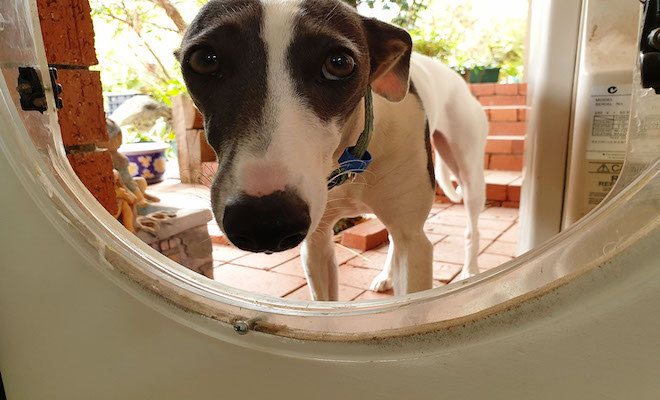
To winterise a pet flap, you should build a tunnel around it, either outside or inside, with the use of a second flap.
You can do so by removing parts of a wooden box and then attaching the box to the door. It is advisable to hang a piece of heavy carpet on the other side of the box.
This way, your cat or dog can still enter through the pet flap without the elements becoming a nuisance, whether through heavy wind, sideways rain, or simply the cold.
Pet Flap Removal Cost
What if I later decide to remove a pet flap? Homeowners may choose to remove pet flaps if they’d like to upgrade to another type of pet flap, such as an infrared or magnetic pet flap.
A replacement pet door flap is likely to cost the same as fitting a new pet flap unless waste disposal costs are included.
Alternatively, homeowners may decide that a pet flap is not worth the hassle or their pet has no interest.
On average, it costs under £100 to have a pet flap removed and disposed of. You may remove a pet flap by yourself if you’d like.
FAQs
However, some pet flaps are much more secure than others, with infrared, magnetic, and microchip pet flaps being the safest options.
A pet flap may need permission if your home is a listed building or if you're in a conservation area. It could also be a condition of a tenancy that you shouldn't make alterations to a property, or there could be other local restrictions. If in doubt, contact your local authority before carrying out the work.
How to Find and Hire a Pet Flap Installer
You may choose to hire a contractor if you feel unsure about the installation process or do not feel certain you would undertake the installation correctly.
On average, tradespeople charge between £40 and £50 an hour for this sort of work.
Here are some points worth considering when hiring:
- Do they have qualifications?
- What about their references?
- What experience do they have?
- What is their accreditation?
- Do they have insurance?
A pet flap installer may have qualifications related to their trade. However, qualifications are not necessary.
Ultimately, their experience and references are the most important points you should take into account.
If, however, you’d like to check their qualifications and certifications, you can always ask the contractor or their employer.
Sources
https://www.money.co.uk/guides/10-things-that-could-invalidate-home-insurance
https://www.fourpawsdoors.co.uk/diy-fitting.html










